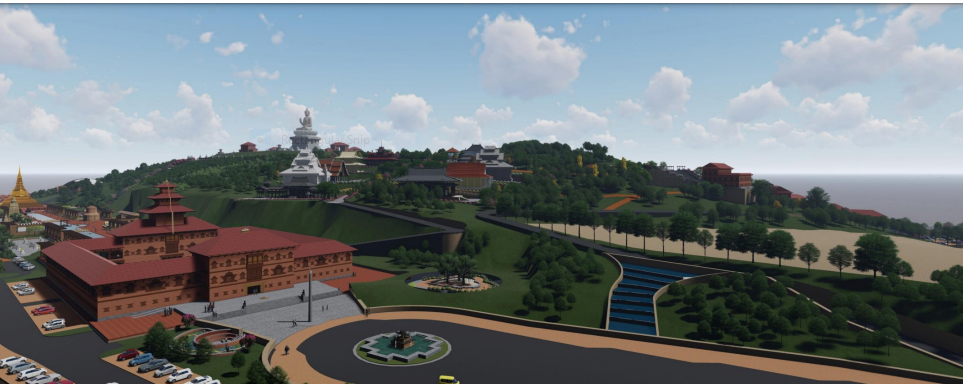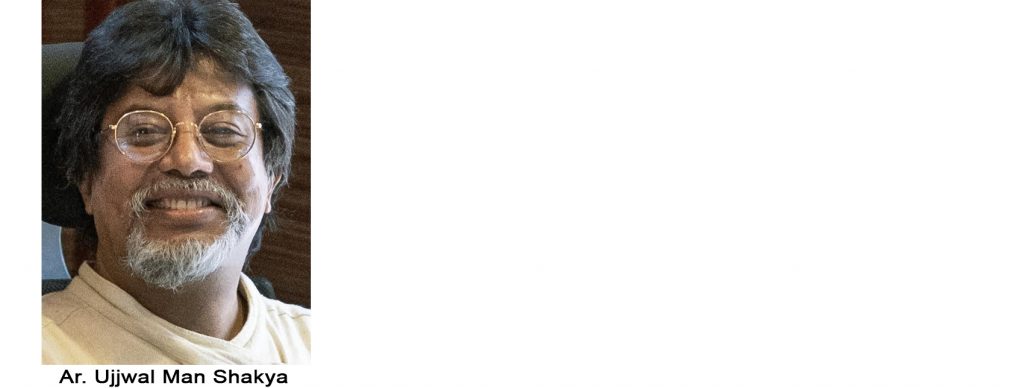Best work of Ar. Ujjwal Man Shakya in a foreign land
 The Nepal Weekly
The Nepal Weekly  July 12, 2022
July 12, 2022
Buddha was born in 623 BC in the sacred land of Lumbini located in the Terai plains of Southern Nepal. The birth place of Buddha was visited by Mauryan Emperor Asoka in 249 BC. He had erected a marking pillar, later known as the Ashoka Pillar.
Fa-Hien was a Chinese Buddhist monk and translator who travelled by foot from China to India to acquire Buddhist texts. Starting his arduous journey about age 60, he visited sacred Buddhist sites in Central, South and Southeast Asia between 399 and 412 CE. History says that Fa-Hian had visited Lumbini and mentioned in his travel records.
The sacred place was visited by Hiuen Tsang, a 7th-century. Tsang, the Chinese Buddhist monk, scholar, traveller, and translator was well known for the epoch-making contributions to Chinese Buddhism, the travelogue of his journey to India in 629 – 645 CE, his efforts to bring over 657 Indian texts to China, and his translations of some of these texts. He also had mentioned Lumbini as the birth place of Buddha.
In 1896, former General Khadga Shamsher Jung Bahadur Rana and Alois Anton Fuhrer discovered a great stone pillar at Rupandehi, which verifies the crucial historical records as mentioned above.
The visit of the UN Secretary General U Thant to Lumbini in 1967 was another milestone event. The visit set the UN’s initiatives for the development of Gautam Buddha’s birthplace. In UN initiative, Japanese architect Prof. Kenzo Tange designed the master plan to develop Lumbini as a pilgrimage and tourism destination was brought into effect in 1978.
The Lumbini Master Plan spreads in an area of 1 mile × 3 mile, oriented along the north-south axis, encompasses three zones (1) the Sacred Garden, (2) the Monastic Zone, and (3) the New Lumbini Village, based on the notion of the path to enlightenment. Each of the zones covers an area of a square mile.
Peace lovers from around the world express that the birth place of Buddha, the apostle of peace should be developed as a Peace Centre.
However, the construction of Lumbini Garden at the birth place of Buddha according to the Master Plan and additions is still continued.
Moreover, with utmost devotism on Buddha’s teaching, such sacred places symbolising the birth place of Buddha had been constructed in China, Taiwan, South Korea and Bhutan.

Lumbini Garden is being constructed in Spain is yet another encouraging message for the Buddhists of the world. Necessary design approval of the project is under process. The ambitious plan has been put forward to build Lumbini Garden in the city Creceres in Province Extremadhura. The LumbniGraden Foundation has put forward plans to build a garden in the city at cost of around NRs. 10 billion. The Spanish Government had provided 117 hector (2300 ropani) of land to the foundation to construct Lumbini Garden. The construction works will be completed by 10 years’ time.
A Nepali architect Ujjwal Man Shakya has been entrusted for the architectural designs and landscape. He had conceptualised extensively to the Lumbini Garden in Spain Project. One of the components of his design approach is to give resemblance of Lumbini Project in Nepal (Designed by Prof. Kenzo Tange), as the Spanish project name itself is “Lumbini Garden Project”. Newar traditional methodology and expertise are incorporated in giving shape, size, construction, interiors, exteriors and landscapes in Shakya’s work.
The Lumbini Garden in Spain will have a 40 meter high Budha statue, Mayadevi Temple, Ashoka Stambha, A place for sacred relics of Buddha, Newar style Bahii (courtyard), 4 sacred Buddhist important pilgrimage including Sarnath, Bodhagaya, Kushinagar, a Buddhism university to accommodate 600 students, temples to be constructed by various nations, Bhagawan Pau, circumbulance pathway, monastery, meditation centre, canal, ponds, a cluster of trees dedicated for “Be a tree” cremation, 2600 Buddha statues to be sponsored by interested persons, big bell, amphitheatre, recreation centre and more others.
The complex will have facilities for a joyful promenade to old persons and disables as well.
The wood carvings and stone carvings will be done by craftsmen both in Nepal and on the spot while bronze works will be done in Nepal.
Thus, Lumbini Garden in Spain will be a showcase of Nepali arts and architecture in Europe besides spreading message of Buddha for peace in the world and human happiness through the Buddha’s teaching.
The Lumbini Garden Project in Spain has been undertaken by Lumbini Garden Foundation which is a Spanish institution created in Extremadura on March 2021 in association with the City of Lumbini, Nepal, with the mission statement which reads as “to promote, coordinate and facilitate cooperation and development programs in cultural, social, artistic, educational, tourist and business matters of all kinds, which value, are the result of or complementary to the activities developed within the framework of the Buddhist Centre”.
The Foundation states that the project would receive supports of Buddhist organisations and individuals from Myanmar, China, Thailand, Sri Lanka and other countries.
The foundation’s chief mentor Neeraj Govind Shrestha says that despite being an ambitious project, there is no major problem in raising funds. Shrestha, who is also a businessman living in Belarus, expresses with confidence says that every peace loving people will join hands for this project to make successful.
Moreover, for designing Lumbini Garden in Spain Ujjwal Man Shakya, born in 1960, who had designed a number of residences, office buildings, guest residences with essences of Newar culture and tradition as well as incorporating energy efficiency and renewable energy technologies have been emerged to be named as good as Prof. Kenzo Tange. His hard work also recalls Arniko, the 13th century artist who went to China and constructed many artistic values there calling Nepal’s great artist in foreign land. Thus, art and culture lovers may find similarities of Arniko and Tange in Ujjwal Man Shakya. (By R.P. Narayan)

